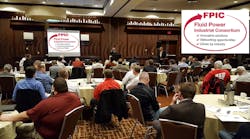The Fluid Power Industrial Consortium (FPIC) will present a half-day technical program titled Advanced Sealing Technologies and Materials for Improving System Reliability. It will be held Dec. 7 at the InterContinental Hotel Milwaukee, 139 E. Kilbourn Ave., in Salons 3 and 4. Consortium members and NFPA member companies can register for free by clicking here. A block of rooms has been reserved at the InterContinental at a discounted rate of $119. Click here or call (414) 935-5943 to book a room.
The program begins at 8 a.m. CST with a light breakfast and face-to-face networking. Then from 8:30 to 9:30, Chuck White, director of commercial development, Hallite, presents Assessing and Managing Rod Seal Friction in Hydraulic Applications: Giveaways and Takeaways.
His abstract states: Rod seal leakage in a hydraulic application can reduce equipment performance and result in hydraulic system failure. While several factors may contribute to rod seal leakage, friction is one of the most common and underestimated causes. Advances in rod seal design, friction assessment methodologies, and materials have improved their reliability. Increased sealing reliability enhances a hydraulic system’s operational efficiency in an environment where cylinders work harder, faster, and for longer cycles than ever before. For more than a century, Hallite has manufactured a variety of fluid power hydraulic and pneumatic sealing solutions for a wide range of applications. The company’s technical and engineering teams have accumulated a wealth of experience and knowledge about seals and their interaction with other components within a hydraulic system. This presentation will provide some practical considerations to manage rod seal friction. Case studies demonstrating how equipment manufacturers have benefited from applying these practices will also be presented.
After a short break, Holger Jordan, technical manager marketing, Europe, Trelleborg Sealing Solutions presents Lubrication Management, Maximize the Lifetime of your Hydraulic Systems Now.
His abstract reads: Effective sealing in demanding hydraulic applications requires seals and lubricant to work together. Trelleborg’s Lubrication Management technology transforms hydraulic sealing by adjusting lubrication conditions of all single sealing elements within a sealing system. Performance; Efficiency; Longevity. These are the things that matter in engineering. They’re also the things that an effective sealing and lubrication system safeguards. Trelleborg’s Lubrication Management technology approaches hydraulic sealing and lubrication systems from a comprehensive perspective, in which each element is a complementary component of a unified whole. Lubrication Management technology uses adequate lubrication to reduce the load on each sealing element, thereby optimizing the performance of the hydraulic system in terms of friction, wear, and lifetime.
After another short break, Tim Girardi, application engineer, System Seals, Inc. will present Analyzing Seal Component Interactions to Maximize Performance and Reliability.
Girardi’s description of his presentation: Through examination of the interactions between sealing components during the design phase of a cylinder, it is possible to minimize the risk of cylinder failure. Performance and reliability of the sealing components can be maximized by expanding this concept further through a sequential process approach that includes analyzing side load, chemical compatibility, [and] surface finish, as well as other considerations.
After a brief recap, the event concludes with lunch from 12 to 1 p.m.
For information about attending by non-consortium and non-NFPA member companies, or other inquiries, please contact Tom Wanke, director FPIC and industry relations, Milwaukee School of Engineering, at (414) 277-7191, or via e-mail.


